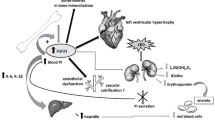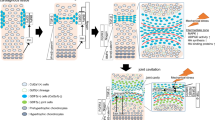Summary
Forelimbs of Day 11 and Day 12 embryonic mice were excised and cultured for 3 d in the presence of either 0.25 μg (8×10−7 M), 0.5 μg(1.7×10−6 M), or 1.0 μg (3.3×10−6 M) of all-rans retinoic acid (RA) per milliliter of culture medium. Cultured limbs were fixed, stained, and mounted whole on glass slides and evaluated with computerized optical image analysis for RA-induced effects on the area and shape of the total limb and individual bone anlagen. Relative effects of RA on total bone, soft tissue, long bone, and paw regions were also examined. With Day 11 forelimbs total bone area was increased by 10.5% by the low dose of RA. The increase was mostly in long bones and at the expense of soft tissue. Total bone area was increased 9.3% with Day 12 forelimbs. This increase was primarily in the paw. The high dose of RA decreased Day 11 forelimb area, primarily affecting long bones. Day 12 forelimbs were not significantly affected by the high dose of RA. Effects of the imtermediate dose were primarily limited to reduction in soft tissue area. Long bone:paw and soft tissue: bone ratios reflected these effects. The high dose produced a consistent rounding or shortening of Day 11 forelimb bones. On Day 12 0.5 μg/ml RA produced an inconsistent pattern of rounding of bone anlagen. Treatment with the high dose on Day 12 produced angular rather than rounded contours in many cases, as indicated by shape factor values closer to zero than obtained with controls. These data show that direct exposure to RA can affect both the size and shape of bone anlagen of the developing limb; the low dose enhances and the high dose depresses development. The results support previous studies which suggest that RA may play a critical role in the control of cell activities such as cell migration, proliferation, and cytodifferentiation in the development of the cartilaginous bone anlagen.
Similar content being viewed by others
References
Andrews, P. W. Retinoic acid induces neuronal differentiation of a cloned human embryonal carcinoma cell line in vitro. Dev. Biol. 103:285–293; 1984.
Ashburner, M.; Chihara, C.; Meltzer, P., et al. Temporal control of puffing activity in polytene chromosomes. Cold Spring Harbor Symp. Quant. Biol. 38:655–662; 1973.
Bishop, J. M.. Oncogenes. Sci. Am. 246:80–92; 1982.
Edwards, M. K. S.; McBurney, M. W. The concentration of retinoic acid determines the differentiated cell types formed by a teratocarcinoma cell line. Dev. Biol. 98:187–191; 1983.
Gallandre, F.; Kistler, A. Inhibition and reversion of chondrogenesis by retinoic acid in rat limb bud cell cultures. Wilhelm Roux's Archives 189:25–33; 1980.
Ganguly, J.; Rao, M. R. S.; Murthy, S. K., et al. Systemic mode of action vitamin A. Vitam. Horm. 38:1–54; 1980.
Kochhar, D. M. Teratogenic activity of retinoic acid. Acta Pathol. Microbiol. Scand. 70:398–404; 1967.
Kochhar, D. M. Cellular basis of congenital limb deformity induced in mice by vitamin A. In: Bergsma, D.; Lenz, W., eds. Morphogenesis and malformation of the limb. New York: Alan R. Liss; 1977:111–124.
Kwarta, R. F., Jr.; Kimmel, C. A.; Kimmel, G. L., et al. Identification of the cellular retinoic acid binding protein (cRABP) within the embryonic mouse (CD-1) limb bud. Teratology 29:43A; 1984.
Kwasigroch, T. E.; Kochhar, D. M. Locomotory behavior of limb bud cells: the effect of excess vitamin A in vivo and in vitro. Exp. Cell. Res. 95:269–278; 1975.
Kwasigroch, T. E.; Kochhar, D. M. Vitamin A alters the adhesiveness of limb bud mesenchymal cells. J. Embryol. Exp. Morphol. 59:325–339; 1980.
Kwasigroch, T. E.; Kochhar, D. M. Production of congenital limb defects with retinoic acid: phenomenological evidence of progressive differentiation during limb morphogenesis. Anat. Embryol. 161:105–113; 1980.
Kwasigroch, T. E.; Skalko, R. G. The teratogenic interaction of hydroxyurea and 5-bromodeoxyuridine examined with the aid of limb culture and image analysis. Fundam. Appl. Toxicol. 5:1161–1173; 1985.
Kwasigroch, T. E.; Skalko, R. G.; Church, J. K. Mouse limb bud development in submerged culture: quantitative assessment of the effects of in vivo exposure to retinoic acid. Teratogenesis Carcinog. Mutagen. 4:311–326; 1984.
Lotan, R. Effects of vitamin A and its analogs (retinoids) on normal and neoplastic cells. Biochim. Biophys. Acta 605:33–91; 1980.
Maden, M. Vitamin A and pattern formation in the regenerating limb. Nature 295:672–675; 1982.
Maden, M. The effect of vitamin A on the regenerating axolotl limb. J. Embryol. Exp. Morphol. 77:273–295; 1983.
Mehta, R. G.; McCormick, D. L.; Cerny, W. L., et al. Correlation between retinoid inhibition ofN-methyl-N-nitrosourea-induced mammary carcinogenesis and levels of retinoic acid binding proteins. Carcinogenesis 3:89–91; 1982.
Muller, R.; Slamon, D. J.; Tremblay, J. M., et al. Differential expression of cellular oncogenes during pre-and postnatal development of the mouse. Nature 299:640–644; 1982.
Niazi, I. A.; Saxena, S. Abnormal hindlimb regeneration in tadpoles of the toad,Bufo andersonii, exposed to excess vitamin A. Folia Biol. (Krakow) 26:3–11; 1978.
Nomura, T.; Enomoto, T.; Shibata, K., et al. Antiteratogenic effects of tumor inhibitors, caffeine, antipain and retinoic acid in mice. Cancer Res. 43:5156–5162; 1983.
Skalko, R. G.; Packard, D. S., Jr. The teratogenic response of the mouse embryo to 5-iododeoxyuridine. Experientia 29:198–200; 1973.
Slamon, D. J.; Cline, M. J. Expression of cellular oncogenes during embryonic and fetal development of the mouse. Proc. Natl. Acad. Sci. USA 81:7141–7145; 1984.
Summerbell D. The effect of local application of retinoic acid to the anterior margin of the developing chick limb. J. Embryol. Exp. Morphol. 78:269–289; 1983.
Thoms, S. D.; Stocum, D. L. Retinoic acid-induced pattern duplication in regenerating urodele limbs. Dev. Biol. 103:319–328; 1984.
Tickle, C.; Alberts, B.; Wolpert, L., et al. Local application of retinoic acid to the limb bond mimics the action of the polarizing region. Nature 296:564–566; 1982.
Tickle, C.; Lee, J.; Eichele, G. A quantitative analysis of the effect of all-trans-retinoic acid on the pattern of chick wing development. Dev. Biol. 109:82–95; 1985.
Wang, S.-Y.; LaRosa, G. J.; Gudas, L. J. Molecular cloning of gene sequences transcriptionally regulated by retinoic acid and dibutyryl cyclic AMP in cultured mouse teratocarcinoma cells. Dev. Biol. 107:75–86; 1985.
Whitten, W. K.; Dagg, C. P. Influence of spermatozoa on the cleavage rate of mouse eggs. J. Exp. Zool. 148:173–183; 1961.
Author information
Authors and Affiliations
Rights and permissions
About this article
Cite this article
Kwasigroch, T.E., Vannoy, J.F., Church, J.K. et al. Retinoic acid enhances and depresses in vitro development of cartilaginous bone anlagen in embryonic mouse limbs. In Vitro Cell Dev Biol 22, 150–156 (1986). https://doi.org/10.1007/BF02623502
Received:
Accepted:
Issue Date:
DOI: https://doi.org/10.1007/BF02623502




